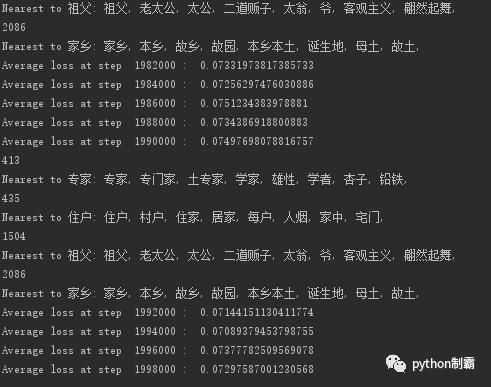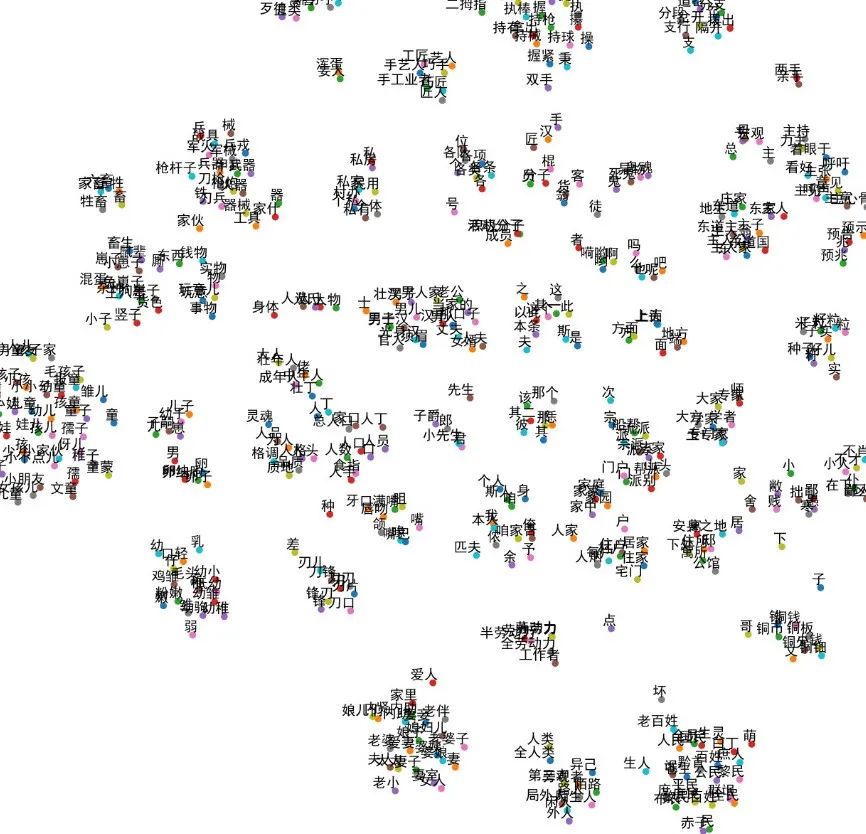Boblee人工智能硕士毕业,擅长及爱好python,基于python研究人工智能、群体智能、区块链等技术,并使用python开发前后端、爬虫等。
本文基于https://zhuanlan.zhihu.com/p/28979653进行修改。
word2vec简要介绍
word2vec 是 Google 于 2013 年开源推出的一个用于获取 word vector 的工具包,它简单、高效,因此引起了很多人的关注。对word2vec数学原理感兴趣的可以移步word2vec 中的数学原理详解,这里就不具体介绍。word2vec对词向量的训练有两种方式,一种是CBOW模型,即通过上下文来预测中心词;另一种skip-Gram模型,即通过中心词来预测上下文。其中CBOW对小型数据比较适合,而skip-Gram模型在大型的训练语料中表现更好。
2. 同义词训练
本文基于哈工大提供的同义词词林进行训练,数据集请见: https://github.com/TernenceWind/replaceSynbycilin

本文训练采取以下步骤:
1. 提取同义词将所有词组成一个列表,为构建词频统计,词典及反转词典。因为计算机不能理解中文,我们必须把文字转换成数值来替代。
2.构建训练集,每次随机选择一行同义词,比如选取“人类、主人、全人类”这一行,输入“人类”预测“主人”,输入“主人”预测“全人类”。
3.python实现
初始化数据
from __future__ import absolute_importfrom __future__ import divisionfrom __future__ import print_functionfrom random import choiceimport collectionsimport mathimport randomimport numpy as npfrom six.moves import xrangeimport tensorflow as tfdata = []all_word = []for line in open('cilin.txt', 'r', encoding='utf8'): line = line.replace('\n','').split(' ')[1:] # line =line.strip('\n') # line = line.split(' ') data.append(line) for element in line: if element not in all_word: all_word.append(element)dictionary = [i for i in range(len(all_word))]reverse_dictionary_ = dict(zip(dictionary, all_word))reverse_dictionary = dict(zip(all_word, dictionary))获取训练集
batch_size = 128embedding_size = 128skip_window = 1num_skips = 2valid_size = 4 valid_window = 100num_sampled = 64 vocabulary_size =len(all_word)#验证集valid_word = ['专家','住户','祖父','家乡']valid_examples =[reverse_dictionary[li] for li in valid_word]def generate_batch(data,batch_size): data_input = np.ndarray(shape=(batch_size), dtype=np.int32) data_label = np.ndarray(shape=(batch_size, 1), dtype=np.int32) for i in range(batch_size): slice = random.sample( choice(data), 2) data_input[i ] = reverse_dictionary[slice[0]] data_label[i , 0] = reverse_dictionary[slice[1]] return data_input, data_label构建网络
graph = tf.Graph()with graph.as_default(): # Input data. train_inputs = tf.placeholder(tf.int32, shape=[batch_size]) train_labels = tf.placeholder(tf.int32, shape=[batch_size, 1]) valid_dataset = tf.constant(valid_examples, dtype=tf.int32) # Ops and variables pinned to the CPU because of missing GPU implementation with tf.device('/cpu:0'): # Look up embeddings for inputs. embeddings = tf.Variable( tf.random_uniform([vocabulary_size, embedding_size], -1.0, 1.0)) embed = tf.nn.embedding_lookup(embeddings, train_inputs) # Construct the variables for the NCE loss nce_weights = tf.Variable( tf.truncated_normal([vocabulary_size, embedding_size], stddev=1.0 / math.sqrt(embedding_size))) nce_biases = tf.Variable(tf.zeros([vocabulary_size]),dtype=tf.float32) # Compute the average NCE loss for the batch. # tf.nce_loss automatically draws a new sample of the negative labels each # time we evaluate the loss. loss = tf.reduce_mean(tf.nn.nce_loss(weights=nce_weights, biases=nce_biases, inputs=embed, labels=train_labels, num_sampled=num_sampled, num_classes=vocabulary_size)) # Construct the SGD optimizer using a learning rate of 1.0. optimizer = tf.train.GradientDescentOptimizer(1.0).minimize(loss) # Compute the cosine similarity between minibatch examples and all embeddings. norm = tf.sqrt(tf.reduce_sum(tf.square(embeddings), 1, keep_dims=True)) normalized_embeddings = embeddings / norm valid_embeddings = tf.nn.embedding_lookup(normalized_embeddings, valid_dataset) similarity = tf.matmul(valid_embeddings, normalized_embeddings, transpose_b=True) # Add variable initializer. init = tf.global_variables_initializer()开始训练
num_steps = 2000000with tf.Session(graph=graph) as session: # We must initialize all variables before we use them. init.run() print("Initialized") average_loss = 0 for step in xrange(num_steps): batch_inputs, batch_labels = generate_batch(data,batch_size) feed_dict = {train_inputs: batch_inputs, train_labels: batch_labels} # We perform one update step by evaluating the optimizer op (including it # in the list of returned values for session.run() _, loss_val = session.run([optimizer, loss], feed_dict=feed_dict) average_loss += loss_val if step % 2000 == 0: if step > 0: average_loss /= 2000 # The average loss is an estimate of the loss over the last 2000 batches. print("Average loss at step ", step, ": ", average_loss) average_loss = 0 # Note that this is expensive (~20% slowdown if computed every 500 steps) if step % 10000 == 0: sim = similarity.eval() for i in xrange(valid_size): print(valid_examples[i]) valid_word = reverse_dictionary_[valid_examples[i]] top_k = 8 # number of nearest neighbors nearest = (-sim[i, :]).argsort()[:top_k] log_str = "Nearest to %s:" % valid_word for k in xrange(top_k): close_word = reverse_dictionary_[nearest[k]] log_str = "%s %s," % (log_str, close_word) print(log_str) final_embeddings = normalized_embeddings.eval() np.save('tongyi.npy',final_embeddings)可视化
def plot_with_labels(low_dim_embs, labels, filename='images/tsne3.png',fonts=None): assert low_dim_embs.shape[0] >= len(labels), "More labels than embeddings" plt.figure(figsize=(15, 15)) # in inches for i, label in enumerate(labels): x, y = low_dim_embs[i, :] plt.scatter(x, y) plt.annotate(label, fontproperties=fonts, xy=(x, y), xytext=(5, 2), textcoords='offset points', ha='right', va='bottom') plt.savefig(filename,dpi=800)try: from sklearn.manifold import TSNE import matplotlib.pyplot as plt from matplotlib.font_manager import FontProperties font = FontProperties(fname=r"simhei.ttf", size=14) tsne = TSNE(perplexity=30, n_components=2, init='pca', n_iter=5000) plot_only = 100 low_dim_embs = tsne.fit_transform(final_embeddings[:plot_only, :]) labels = [reverse_dictionary_[i] for i in xrange(plot_only)] plot_with_labels(low_dim_embs, labels,fonts=font)except ImportError: print("Please install sklearn, matplotlib, and scipy to visualize embeddings.")4.实验结果
训练结果

从图中可见 同义词基本训练出来了。

5.结语
本文基于前人的基础上实现了同义词词向量生成,下一步就可以用于nlp文本处理了。





















 1276
1276











 被折叠的 条评论
为什么被折叠?
被折叠的 条评论
为什么被折叠?








